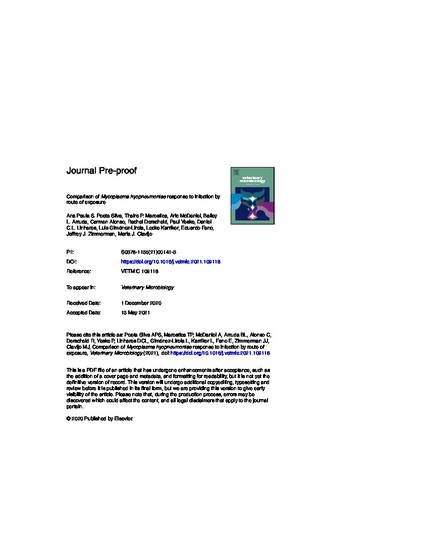
Mycoplasma hyopneumoniae (MHP) is a concern both for pig well-being and producer economic viability. In the absence of fully protective health interventions, producers rely on controlled exposure to induce an immune response in pigs and minimize the clinical outcomes of MHP infection in pig populations. This study compared the effect of route of exposure on MHP infection, antibody response, clinical signs, and pathology. Six-week-old MHP-negative pigs (n = 78) were allocated to negative control (n = 6) or one of three MHP exposure routes: intratracheal (n = 24, feeding catheter), intranasal (n = 24, atomization device), and aerosol (n = 24, fogger). Body weight, cough indices, and samples (serum, oral fluid, tracheal) were collected weekly through 49 days post-exposure (DPE). Intratrachal exposure produced the highest proportion (24/24) of MHP DNA-positive pigs on DPE 7, as well as earlier and higher serum antibody response. Intranasal and aerosol exposures resulted in infection with MHP DNA detected in tracheal samples from 18/24 and 21/24 pigs on DPE 7, respectively. Aerosol exposure had the least impact on weight gain (0.64 kg/day). No difference was observed among treatment groups in coughing and lung lesions at necropsy. While intratracheal inoculation or the use of seeder animals are frequently used in swine production settings, intranasal or aerosol exposure are viable alternatives to achieve infection. Regardless of the route, steps should be taken to verify the purity of the inoculum and, in the case of aerosol exposure, avert the unintended exposure of personnel and animals to other pathogens.
Available at: http://works.bepress.com/daniel-linhares/85/

This is a manuscript of an article published as Silva, Ana Paula S. Poeta, Thaire P. Marostica, Aric McDaniel, Bailey L. Arruda, Carmen Alonso, Rachel Derscheid, Paul Yeske et al. "Comparison of Mycoplasma hyopneumoniae response to infection by route of exposure." Veterinary Microbiology (2021): 109118. DOI: 10.1016/j.vetmic.2021.109118. Posted with permission.